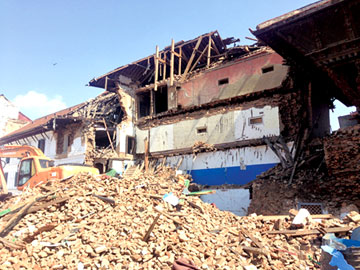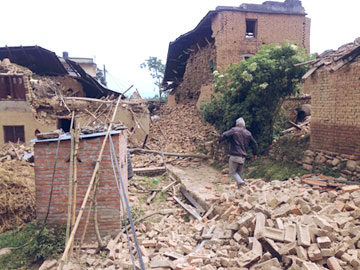Living with the fear of being buried alive
Nepali journalist Ujjwal Acharya recounts the horrors
of the 7.8 earthquake and the continuing nightmares that haunt the
nation:
by Dilrukshi Hadunnetti
|

Ujjwal Acharya |
Ujjwal Acharya tries to appear nonchalant and speaks with the
controlled tone of a seasoned journalist. Yet, what he has witnessed on
April 25 as a 7.8 Richter Scale earthquake hit Nepal, “causing
everything about me to violently shake or collapse,” has clearly
affected him.
Being Nepali and having experienced a few tremors in his childhood,
Acharya thought he was ready for anything, until he saw his much-loved
city crack up and parts of it turn into rubble, taking with devastating
impact, people he daily associated with or saw regularly on the street.
“I never thought, despite being constantly reminded of Nepal’s
vulnerability to natural disasters, this could happen and with such
devastating impact. I had to see it to believe it,” says Acharya.
The first thing he mentions as we meet is the need to train
journalists in trauma journalism, post quake, and admits to being
“completely shaken by the death of Suman Bomjan (30), a sports
journalist with the State-owned Nepali daily, Gorkhapatra, whose body
was recovered from the rubble of his house at the Bhotahiti Galli of
Kathmandu on May 2.
“I saw his body being unearthed. I saw the road crack up before my
eyes and buildings shake violently. Places that I loved were reduced to
rubble but seeing Suman’s body drove the harsh reality of the extent of
devastation, sharply home.”
Quake survivor
Acharya, a Katmandu-based journalist, activist, co-founder/blogger at
United We Blog!, South Asia Coordinator for the International Federation
of Journalists(IFJ) and Director, South Asia Media Solidarity Network (SAMSN),
feels that a huge effort is required for Nepal to recover from its
current predicament.
Acharya was visiting Colombo as a member of an international media
mission, when a 7.3 magnitude earthquake hit Nepal on May 12, which
killed over 110 Nepali people, this time also impacting India and China.
“We need a reliable early warning system. Just knowing that we are in
the danger zone won’t do,” he notes.
As a child, he had experienced mild earthquakes. They were quick and
not terrifying. There had been tremors and as kids, they ran out of
their homes only to find nothing had changed. “April 25 however, changed
everything. The fear of being buried alive is now very real, for all of
us.”
 |
 |
|
Soon after the
earthquake Pix: Ujjwal Acharya |
Acharya, a computerholic, was working on his laptop on Saturday,
April 25 when the quake hit Nepal. He was still in bed and his wife was
seated at the writing table, working on her laptop.
“Suddenly, everything began to shake. My laptop slipped off my lap.
That single minute when the quake struck was the longest minute in my
life. It was like one huge splash: Then heavy silence. ”
Acharyas’ dressing table collapsed in an instant and the terror-
struck couple, ran out of the second-storey home, to the open area.
Hundreds of terrified people were gathered in that open space. Acharya’s
82 year-old father was being helped by a neighbour. To come out of the
ground floor of the building, together with his mother, both appearing
terrified.
Acharya says: “Nepalese believe that an earthquake returns. We expect
it to return. That’s probably how people explain aftershocks and
demonstrate resilience.”
Outside, Acharya began tweeting with little idea about the enormity
of the earthquake. When he called a friend ‘to inform’, Acharya was told
that the iconic Dharahara tower has collapsed and people were trapped
within the Durbar Square.
The tour
When Acharya walked 100 metres to reach the newly built- six-laned
Arniko Highway, he was stunned by the deep crack that had split the new
highway. “I could still feel the multiple shakes as the Earth angrily
moved. I could see buildings sway and suddenly chunks falling down. It
was like watching a horror movie. Every road had cracks, every
building.”
Meanwhile, the city had no electricity. When electricity and internet
connectivity were restored, there was a gush of info-sharing taking
place, as the Himalayan nation suddenly became the focus of global
attention. People began listening to the radio but channels got jammed
as Nepal experienced general chaos, natural in the aftermath of a
catastrophe.
A little later, the Acharyas decided to venture out, with cameras in
hand. “The beautiful heritage temples and narrow alleyways were ravaged.
Katmandu Durbar Square suffered the most with four historic temples
destroyed, in addition to the palace complex. Bkaktapur and Lalitpur too
were affected, to a lesser degree. Looking around, tears filled my eyes
as I took in how our cities have been destroyed, taking away our
heritage and identity. I didn’t know, but could sense, the quake would
have devoured hundreds of lives. “
To Acharya, the heritage squares with their temples meant a lot. “I
felt like crying. The very identity of our historic city was lost. The
people who lived in the closely-built Newari homes, everything that was
familiar, appeared to have gone. In a minute. I stood there, shocked and
horrified, my anguish beyond words. It is still.”
Wherever he went, all he could see was people rushing out, screaming
crying. So much anguish and terror on their faces. I was grateful to see
many houses still standing and silently prayed for their safety. I felt
completely helpless, unable to help these people meaningfully.”
According to Acharya, police didn’t arrive quickly enough and
individuals began helping those who were trapped. People were using
their bare hands to dig through the soil and he watched as young men
help a trapped lady to come out.
Locals helped in saving many lives despite their own plight. People
seemed to have bonded over shared grief. It was also how people overcame
their own grief and safety concerns to reach out to others. “I saw both
Nepali compassion and courage.”
|

Captured from the rooftop |
The Acharya family, like thousands of others, spent four days in the
open area. The slight tremors were felt for about a week. Thankfully, it
was not winter and there was no rain. “That would have complicated
relief operations and increased the deaths,” he notes.
Feeling helpless, Ujjwal Acharya joined the tweeting community,
offering updates and sharing photos. “We were tweeting our agony as well
as info. We were trying to identify specific needs and galvanize people
to assist those in need.”
Nepal hasn’t had local elections in years and this retarded the
government response, in addition to a poor disaster management
mechanism, he says.“The government took hours to respond and by then,
India has sent the first rescue mission. Neighbouring countries like
India, Sri Lanka, Pakistan, China and Turkey were swiftly responded.
They were all efficient and did their job well. The Chinese used small
robots with external cameras that helped identify buried people. Turkish
had sophisticated instruments to make cuts and create holes. The Sri
Lankan and Indian teams have rescued people and helped with emergency
evacuations. It was comforting to know that others cared for us and
there was this surge of human response to help Nepal.”
Emergency communications
Acharya believes the April 25 earthquake should be treated as a “big
eye opener.” Nepal needs sound disaster preparedness and this requires a
multi-pronged approach and proper co-ordination among government
agencies. “We must learn how to handle a massive disaster and the
effective use of technology. At present, we only have a National
Emergency Operations Committee which is sorely inadequate.”
Currently, the Nepalese Police furiously tweets and offers regular
updates on its Facebook page, including locations of the missing, urgent
needs and information on relief teams.
If the police quickly got its act together, Acharya says, the rest of
the response was weak. “Home Ministry complained that the Nepal Army
failed to follow instructions but the Army takes orders from the
Ministry of Defence only. So there was lack of coherence and a co-ordinated
disaster response. Information was being released by different agencies
and there was confusion.”
Disaster mapping
In the aftermath of the devastating earthquake, 22 out of 75
districts in Nepal have been classified as affected and -quake prone.
The Nepal Government has announced an ambitious reconstruction programme
at an estimated cost of Nepali Rs. 6 billion, to be concluded in two
years.
“They are currently mapping damages. Future models must include the
use of technology and new construction methods to withstand disasters,”
Acharya adds.
Nepal, besides the relief missions, also witnessed the frenzied
arrival of foreign journalists. “Mostly, the coverage was responsible
though some proved excessive and dramatic. As a media watcher, I also
saw how people negatively responded to two international television
channels, BBC and CNN.
The interviewees were only foreign relief workers or NGO
representatives. They overlooked local voices completely. It was biased
and uncaring and the Nepali people objected to this.”
Closer home, Indian media coverage turned largely jingoistic,
converting the Indian relief operations into acts of unusual heroism.
“The information packaging was largely insensitive.
They talked to a lot of locals but most interviews were biased and
insensitive. Resentment against this jingoistic reportage resulted in a
spontaneous gohomeIndianmedia campaign.”
Amidst the rubble, Acharya says he is touched by the resilience shown
by Nepali journalists. “Many media houses operated from tents, such as
Kantipur. The number of pages was reduced but they still printed.
Newspapers for days, only reported the earthquake. As they continue to
do their job, I am aware how traumatized our journalistic colleagues
are,” adds Acharya.
“I don’t recall how I got out of the house or how I wore shoes. I
reacted with shock and terror. I only saw a single body, of Suman Bomjan,
the journalist who died. That image haunts me still. I am amazed by the
resilience shown by reporters and photojournalists who covered the
earthquake in the immediate aftermath. I am horrified by the thought
that they would have done their job, while having lost their own homes,
family members and friends.
“They are dealing with personal trauma as a result of their
profession. There is no psycho- social help for them.”
For Ujjwal Acharya, this is all important. “Nepal journalists
continue to cover the devastation. When they take a break, have a silent
moment, the horrifying experiences will come to haunt them. That day,
the industry must be prepared to assist them. We need to train them in
handling trauma and covering disasters.” |

